While in Chalalan, we’d decided to attempt to climb 6,088 m Huyana Potosi; neither of us was in any kind of climbing shape, but the mountain charmed us when we flew by its upper portions last week, and so we agreed to give it a try. Both of us are well-schooled in the world of altitude, and we were both willing to accept our limitations and turn back should warning signs of trouble occur. We knew that climbing to over 20,000 feet in elevation was probably overly ambitious, but when else would we get such a good chance to climb in the Andes?
 Another climber had recommended a guiding company, aptly if not creatively named Huyana Potosi, so we wandered over to check it out back in La Paz after our return from the Amazon. We were encouraged to hear that they buy new gear every year, and the ratio was one guide to two climbers (three at the most). The prospect of a rope team consisting of an experienced guide with only Sarah and I, as opposed to a bunch of newbies was enticing, and the price fit within our budget, so Sarah and I signed up to attempt the highest mountain that either of had ever climbed , beginning the very next day!
 We had been staying at a hotel in La Paz that was aimed more at locals than tourists, and so it was clean, quiet, and a very good deal. Breakfast was my favorite part of the experience, though, and so I was glad to get one more desayuno there before heading up to the mountains. A tiny old woman, who for some reason wore a pharmacist’s jacket everyday and spoke unintelligibly to foreigners and Bolivians alike, served fresh juice, café con leche with just a splash of coffee and a lot of warm milk, and delicious bread rolls. If she liked you on a particular day, she would give you three rolls, but if you were too early, too late, or looked at her funny when she was apparently asking whatever strange phrase meant, “and what would you like to drink,†it would result in the loss of one bread roll. Today was a good day, and we got three to power us up the mountain.
 Our first stop was the company’s warehouse, where they fitted us with plastic boots (in all the years I’ve been climbing, I don’t think I’ve ever worn plastics before), bib snow pants that came down to mid-shin, a shell jacket, ice ax, and crampons. Some of the others rented sleeping bags, gloves, and headlamps as well; they had it all available. We had plenty of good cold weather gear already, but I was thankful to get an extra layer anyway, and the technical stuff looked fine. I checked out the ropes, which were fairly new and looked to be in good condition; I supposed that they probably kept the helmets up at the base camp.
 After getting geared up, we had to wait for three additional climbers who had shown up 40 minutes late to the office; two of them were Dutch but lived in La Paz , and they joked that they were on Bolivian time. A French guy who currently lived in Houston (I joked that he probably lived in the only state where his accent wouldn’t help him get some action), and a young Danish dude rounded out our group. I was glad that they were all pretty fit, since we would be staying together on the climb, but I was also still relieved to have the small rope team because only one had ever climbed.
 Our base camp of 4700 m was a simple bus ride along a gravel road; several villages were situated up there, and the number of people who live at these high altitudes still surprises me after three weeks in Bolivia. Camp, which was actually a small comfortable lodge, was set right above a lovely aquamarine lake with rocky hills and giant snow-covered mountains, including Huyana Potosi, surrounding it and towering far above us. We settled into our bunk bed accommodations, donned our high water bibs, and geared up for snow school, which would begin after lunch. Sarah had talked me into being a vegetarian, something that the Bolivians don’t fully understand (we had to tell at least 3 different people at the office that chicken was indeed a meat), so I watched with a forlorn gloom as the others gobbled their milenasa while I poked gingerly at a blocky white gob that they informed me was fried cheese but looked suspiciously like Spongebob Squarepants.
Having fueled up and possibly murdered a popular children’s cartoon figure, we hiked up the mountain for about 45 minutes and threw on our plastics and crampons. Back at the lodge, Sarah and I had shown the others how to sling their ice axes onto their bags without endangering anyone else with impalement while they hiked. We weren’t exactly excited to be spending the afternoon “learning†how to walk in crampons and hold an ice ax, but we needed the day at elevation to help us acclimatize.
One thing had begun to bother me, however; contrary to all of the pictures in the office, I had yet to see any helmets, except on the other companies’ teams. I wasn’t really concerned for snow school or the hike to high camp the next day, but I damn sure wanted one for the actual climb. When I asked about it, Eduardo (our guide) explained that the climb wasn’t considered technical and helmets weren’t needed. We discussed this a bit, aided by the translations of the Dutch Bolivians, and I pointed out that the other companies seemed to treat the climb as technical, considering that all the clients wore helmets. Eduardo responded by asking me if I’d ever climbed before, and both Sarah and I responded, “YESâ€! I added that if we were using ropes, axes, and crampons, that the climb was indeed a technical climb and made it very clear that I would not be joining the climb if the proper safety equipment didn’t show up for my use. Our resistance was persuasive to the newbies as well, who seemed to like the idea of getting back down the mountain with brains intact, and Eduardo promised to have helmets sent up from La Paz the next morning before we proceeded up to high camp.
Basically, snow school consisted of practicing French technique (foot over foot) and duck walking (toes pointed out for steeper moderate slopes) in our crampons. After traipsing around in the snow for a bit, Eduardo demonstrated using the pick of the ax and the front points of our crampons to climb up and down high angle snow…which, I thought, certainly sounded like a technical section of climbing to me. One of the assistants, however, did give me a helpful tip on using my ice ax more efficiently when down climbing on high angle stuff, though, so I was happy to get a little something out of snow school. I was a little surprised that we didn’t do anything on a rope or ice ax arrest, but at least my rope team would be full of competent members (I later found that the guides tended to short rope their clients and often basically dragged them to the summit). In any case, the helmet crisis was resolved, and Sarah and I had gained some exercise at the higher elevations. All in a day’s work for the Raffs.
Our evening meal was a bit better, although I’d never thought of topping mashed potatoes with fried vegetables and a fried egg, but at least I could eat everything in good conscience without wondering how I would explain things to Matthew and Kylie, our neice and nephew, when they asked why Spongebob no longer walked with the same swagger. We drank a lot of water and decaf tea in hopes of hydrating well enough to fend off altitude sickness. The cook’s adorable little bonnet-clad daughter, Beba, who claimed to be 10 but must have been 4, kept Sarah busy pretending to fall off the hearth, only to have Sarah catch her in her moment of desperation.
Sarah had not felt well at dinner or before bed, but she slept through the night and woke up feeling much better. A light in the hallway shone directly in my eyes, and all of the liquids forced multiple trips to the bathroom, so I wound up spending my 2nd sleepless night in a row (too excited to sleep in La Paz), which was a bit worrisome to me. It was my turn to feel pretty crappy the next morning, but I managed to eat a little and drank several cups of tea. By lunchtime, both Sarah and I were feeling better, although we had to hide upstairs from Beba in order to get a little quiet rest before heading up to high camp.
The three hour hike up to high camp would take us to an elevation of 5400 m. We set out after lunch, newly acquired helmets bobbing up and down off of our packs, and hiked up steep scree and rocky paths for an hour before paying a park entrance fee to a little old lady sitting in a rock shelter at around 5,000 m above sea level (No Joke!). It was much hotter than we would have imagined up this high, but the sun was strong without any breeze to cool us down. Sarah was struggling a little with the altitude, but one of the assistants was walking with her in the back of the group. I went to walk with her too but stayed quiet because sometimes a husband isn’t as helpful as he means to be if his wife isn’t feeling so well. Anyway, she got stronger as the day went on, and her pace was just as effective as the “sprint and sprawl†game of “red light, green light†that the rest of the group seemed to be playing. I was surprised that Eduardo didn’t regulate pace more, but then again, I guess he is used to dragging clients up on summit day anyway.
We were really glad to get off the rocks and onto the snow, where it is much easier to walk comfortably by rest stepping…a technique that we taught the others. Both Sarah and I were a little tired but otherwise strong upon reaching high camp, where we spent a few minutes enjoying the panorama of giant Andes peaks and high lakes before diving inside the small hut to get warmer as the sun began to sink. After a quick dinner of soup followed by ramen noodles with tea chasers, all six members of our team got horizontal on a bench that held all of our sleeping bags. There wasn’t much wind, so we were pretty cozy. I ventured outside before sunset because almost nothing compares to those final few moments of orange and pink glow before the sun kisses the snowy slopes and peaks good night.
Sleeping at 5400 m (17, 820 ft) is not easy; your lungs and your heart just won’t settle down. In the conflict between sleep loss and water loss, I chose the former, hoping that a hydrated body could overcome lack of sleep, even for a third night in a row. I must have dozed off a little, or at least shut down, but I felt pretty crappy when the alarm went off at midnight. I forced myself to chug a portion of yogurt, which is most often served as a breakfast drink here, and chugged two mugs of tea in hopes that once I got a little fuel and some fresh air, things would be okay. It seemed to work, and Sarah was feeling all right, too, if not overly energetic.
The night was clear but had become quite breezy over the previous hour, and the stars of the Southern Cross twinkled over our heads as we set out at around 1:00 AM; we could also just see the lights of La Paz peeking through a gap in the mountains. Eduardo and the guides kept a good portion of rope coiled into their packs in case of emergency, and we were positioned only 12 or 15 feet apart. Our only instructions were on which side to keep the rope and which side to hold our ax, with a reminder that the rope should be kept tense (not difficult with such a short rope).
Our climb began with a fairly long snow traverse on reasonably flat terrain. I was glad to be feeling better, but this was far from my strongest day. Sarah wasn’t doing too well either, but we both thought maybe we just needed to warm up. The trail got much steeper, and Eduardo’s pace was tough to follow; it’s especially hard to get a rhythm on a short rope, half a step is the difference between way too slow and way too fast. After about an hour, we stopped for a break, and I choked down two Oreos (never again at high altitude; it’s like chewing baked mud) and slugged down some water, but I was concerned to see that Sarah wasn’t eating and only took a minute sip of water. She clearly wasn’t feeling any better and was expressing doubt about continuing. Eduardo offered to slow down a bit before motoring up the hill chanting, “Lento and continuoso†at exactly the same pace he’d set before the break.
Fifteen minutes later, Sarah’s condition had worsened, and she was having trouble deciding whether she could continue. Everyone was trying to encourage her, which was nice but not safe for someone exhibiting so many signs of altitude sickness…when your head, stomach, and awareness level are all worsening by the minute, it’s time to wait for another day. I hated to see her disappointed, but I suggested that she go down, and I offered to go back with her. She decided that she would try to go a little farther, and we agreed to go 15 more minutes. This time, Eduardo really did slow down quite a bit, and I was grateful.
Just a few minutes up the hill, Sarah needed to stop again, and she agreed that it was time to turn around. I know that it was a really hard decision for her, but I was relieved for her safety, and we could climb a mountain any old day! I offered to go back too, but she basically ordered me to continue, so Asst. Mario led her down, and Eduardo and I tied onto the rope that he had formerly been leading. It is always a bitter decision to turn around on a climb, and I have both respect and sympathy for Sarah’s decision, but mostly I was just glad that she would be okay soon. Besides, there is no shame in calling it at over 17,000 ft.!
We kept an even pace after that; the climb alternated between longish traverses and steep sections of climbing. I hadn’t really realized just how low energy I was myself until Sarah was safely on her way back down to high camp, but I had to laugh because I was committed to the climb now, barring emergency, thanks to Sarah’s order that I march on…I guess she had been able to make decisions after all!
I can’t say that the climb was my favorite. We crossed one crevasse that we sort of just crawled over, but other than that, we basically continued along on a grueling slog in the dark. I did my best to gulp Skittles, M&M’s, and water at every break, but 10 ½ months of travel hadn’t exactly left me a model of physical conditioning. By the time we reached the bottom of the summit block, I was running pretty near empty.
Many of the 20-somethings who have climbed Huyana Potosi with guided groups will tell you how much fun they had and how exciting it was. Anyone can do it! Based on my experience, those folks are either telling lies to cover up how they felt at 5900 m (the physical challenge alone had turned back 6 of 14 teams that day), or they have since tossed down enough Pacena beers to turn their experience into a giant marlin of a fish story.
The reality is that the summit ridge is fairly technical, high angle, and very exposed on each side; it is nothing that I wasn’t qualified to climb (a solid “C” climb in the Mazamas), but very few precautions were taken to make it safe. Rope teams climbed about 5 feet apart, and there was no protection set on the route. Many of the new climbers were freaked out by the terrain itself, and I was pretty nervous to be climbing this crap with a bunch of people who had never been on a rope or swung an ice ax before! The problem is that the ridge sneaks up on you, and you are pretty committed (1/3 of the way up the narrow, crowded ridge) by the time you realize how badly things could go at any second. Fuelled by a mixture of adrenalin, anger, and a bit of fear that I was in fact pulling the two people behind me up the ridge–I was not about to let Eduardo drag me to the summit–I stuck my head down, chopped away, and got my feet set firmly in the snow (thanking God for my helmet and simultaneously cursing the fact that I didn’t have another one to for my rearend), and made my way up to the summit.
As I sat at 6,088 m (almost 20,100 ft.) watching the sunrise, I didn’t really know what I felt: tired mostly but also somewhat fulfilled at having dogged my way up that mountain. The summit was beautiful…tons of mountains all around, La Paz and Lake Titicaca both in the distance; it was a spectacular place to be. I was tired, though, pretty to close to my current limits, and really wishing that Sarah was with me to share the summit views. I was glad when we headed back home.
The angle on our descent was a lot easier; we could stay on our feet and use the axe in normal position. The newbies led us down, and I was very, very vocal with reminders not to pull on the rope every time we approached a steep section. Other groups were still going up, but the guides worked very well together to keep teams from getting tangled. I just concentrated on my feet and my axe and tried to forget how tired I was; the cough I always get on cold, dry mornings on the mountain had set in, and my head and ribs were hurting from the hacking…I can only describe the final hour back to camp as a glorified stumble on my part, but I seemed to keep up with the team just fine. When we got to camp, I realized that they were just as done as I was, as well.
Sarah was waiting outside for me when we came into camp; she had slept all morning and had taken a little tea while waiting for us. She still didn’t feel good, but she was back on the mend. When she saw me, my amazing wife who had to be both disappointed and half-sick with after-effects gave me a hug and a kiss, told me that she was proud of me, and helped me take off my crampons. She even wanted to hear about the rest of the climb. I’m a lucky man!
I am really glad that we climbed Huyana Potosi, and of course, I am excited to have eclipsed the 6,000 m mark for the first time; one of the best parts of Bolivia is its amazing mountains, and it is an experience that I will never forget. That being said, I’m too old to go climbing mountains when I’m tired and out of shape. No mas!
 

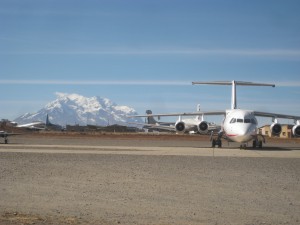
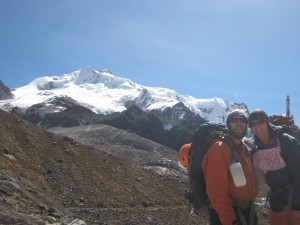
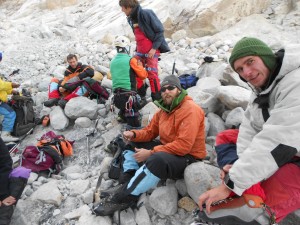
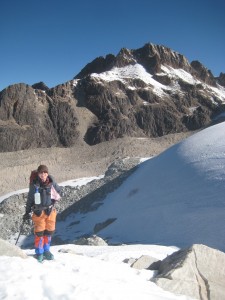
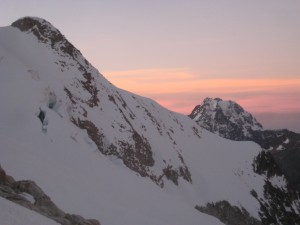
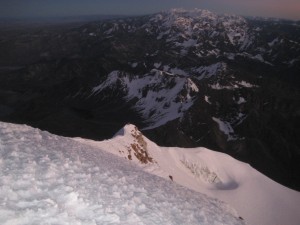


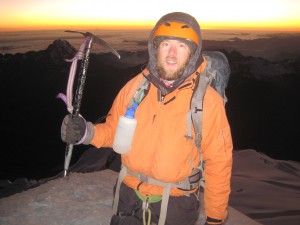
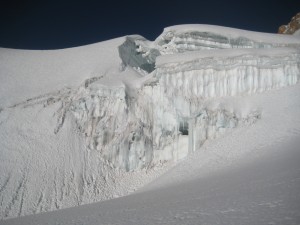

Congrats on getting to the top Mike. Sarah, I’m sorry you didn’t make it. I know your past experience has taught you that altitude is not your forte, so getting up to 17000 feet is pretty impressive. I know I had a pounding headache from the time I went to bed in the Refugio until I got back down to the Refugio. And I was on Diamox.
Mike, you’re spot on about the last part of the ascent. We had people give up in total exhaustion only 500 feet from the top. It was just sheer will that made me force one foot in front of the other. And once you reach the summit ridge and the thousands of feet of exposure on the other side, a rather benign “dog route” suddenly gets very ‘exciting’.
I don’t know about when you were there, but the summit isn’t flat either. It angles downslope, which is a bit disconcerting.
Steve
Good call on the slippery sloping summit, Steve. You are absolutely right. We were nice and acclimated by the time we hit the Salkantay area and Machu Picchu!
Thanks Steve! Yes, high altitude is not my friend! I did enjoy the climb and was proud of how far I made it.
Congrats on Getting High. Although, I felt pretty high myself just looking at the color choices of your climbing clothes!!!
You guys are hardcore to attempt the climb after “vacationing” for so long.
A+ for both your efforts.
Thanks, Trung! I doubled as a traffic cone on the way back into La Paz…
Mike, you look like a Nepal climber with the beard, I really like it and sounds like both of you used your heads and did the right thing in both cases. The scenery was absolutely breathtaking…….
Thanks, Doug! It was a beautiful place; I wish that we had been able to take more pictures…we had an alpine start, and my flash is broken.